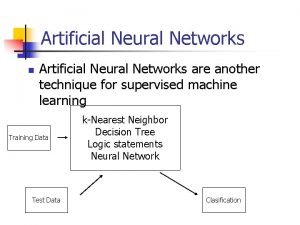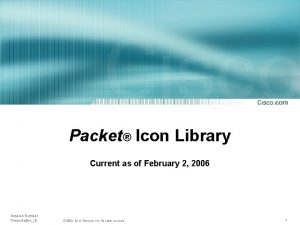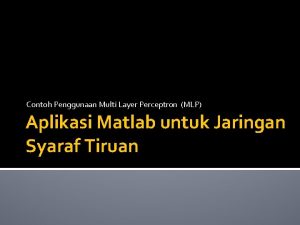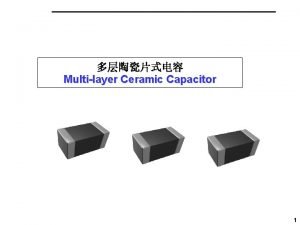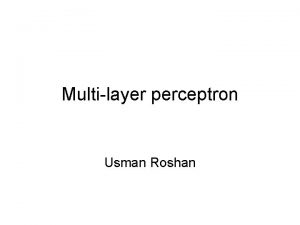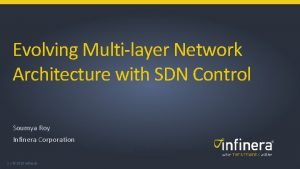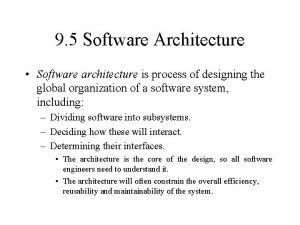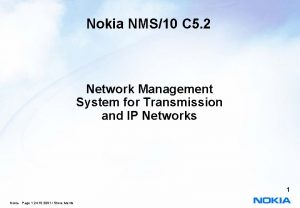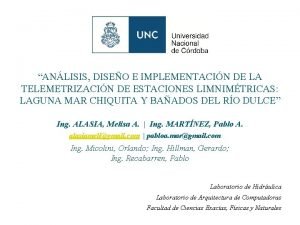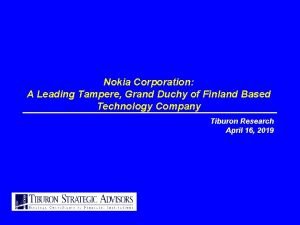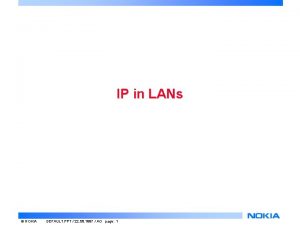MultiLayer Scenarios Andrea Mazzini Nokia May 8 2020



![NEP Attributes (1/2) Node. Edge. Point • • pool: Boolean [1] (default: false) _aggregated. NEP Attributes (1/2) Node. Edge. Point • • pool: Boolean [1] (default: false) _aggregated.](https://slidetodoc.com/presentation_image_h2/588b70d8c3aee8d14f3ada953189ec30/image-4.jpg)
![NEP Attributes (2/2) Node. Edge. Point • • pool: Boolean [1] (default: false) _aggregated. NEP Attributes (2/2) Node. Edge. Point • • pool: Boolean [1] (default: false) _aggregated.](https://slidetodoc.com/presentation_image_h2/588b70d8c3aee8d14f3ada953189ec30/image-5.jpg)
![Node. Edge. Point • • pool: Boolean [1] (default: false) _aggregated. Node. Edge. Point: Node. Edge. Point • • pool: Boolean [1] (default: false) _aggregated. Node. Edge. Point:](https://slidetodoc.com/presentation_image_h2/588b70d8c3aee8d14f3ada953189ec30/image-6.jpg)

![Node Rule Group Attributes Add supported. Transition: Supported. Transition [*] Supported. Transition: couple of Node Rule Group Attributes Add supported. Transition: Supported. Transition [*] Supported. Transition: couple of](https://slidetodoc.com/presentation_image_h2/588b70d8c3aee8d14f3ada953189ec30/image-8.jpg)














































- Slides: 54

Multi-Layer Scenarios Andrea Mazzini, Nokia May 8, 2020

Purpose of this contribution • This contribution provides a synthesis of the various multi-layer scenarios presented in otcc 2018. AM. 003 -Multilayer_Termination-22 nov. pptx (AM, KS). • Purpose is to share and possibly consolidate how to model more common use cases / scenarios, allowing a TAPI agent to consistently represent network multi-layer forwarding capabilities. • The examples consider the transport of Ethernet/DSR services over OTN ODU/OTSi infrastructure, nevertheless the approach should be valid for other connection-oriented networking technologies. • The scenarios are based on equipment view, i. e. most of the shown nodes have a scope on a piece of eqp like Transponder and ROADM. • This version adds the representation of • more flexible layer multiplexing capability • spectrum capability

NEP Pools can be built according to the following criteria: • Pool of NEPs with equivalent transmission features • Further refined according to topological equivalence Internal NEP Pools (NEP not ending link) • Single Layer • Not applicable UNI/E-NNI NEP Pools (NEP not ending link) • Single Layer • Can support SIPs for the provisioning of “CTP rate” Connectivity. Services • Supports flexibility at TTP=CTP rate • • Multi-rate/layer • Can support SIPs for the provisioning of “CTP rate” Connectivity. Services • The terminated layers end trails towards UNI, not explicitly modeled I-NNI NEP Pools (NEP ending Link) • Single Layer • Cannot support SIPs • Supports flexibility at TTP=CTP rate • NEP Pools Multi-rate/layer • Can support SIPs for the provisioning of “TTP rate” Connectivity. Services • Can support SIPs for all the terminated layers • Cannot support SIPs for the provisioning of “CTP rate” Connectivity. Services Transitional Link NEP Pools • The “supported flexibility” lists the rates where flexibility is supported. • Client NEP can support SIPs (related to TTPs) only if Multi-layer • Server NEP can support SIP at its base TTP, plus other SIPs (related to other TTPs) only if Multi-layer Multi-rate/layer • Can support SIPs for the provisioning of “TTP rate” Connectivity. Services • Can support SIPs for all the terminated layers • Cannot support SIPs for the provisioning of “CTP rate” Connectivity. Services 3
![NEP Attributes 12 Node Edge Point pool Boolean 1 default false aggregated NEP Attributes (1/2) Node. Edge. Point • • pool: Boolean [1] (default: false) _aggregated.](https://slidetodoc.com/presentation_image_h2/588b70d8c3aee8d14f3ada953189ec30/image-4.jpg)
NEP Attributes (1/2) Node. Edge. Point • • pool: Boolean [1] (default: false) _aggregated. Node. Edge. Point: Node. Edge. Point [*] layer. Protocol. Name: Layer. Protocol. Name Nep. Base. Layer. Protocol. Qualifier: Layer. Protocol. Qualifier [1] • Layer=ODU 4 (TTP rate) • _capacity: Capacity. Pac [1] • Total Capacity=400 G • available. Cep. Layer. Protocol: Nep. Layer. Protocol. Capability [1. . *] • Supported CTP Rates= ODU 2, ODU 2 e, ODU 3 • Max # CTP per TTP instances=10, 2 • max. Nep. In. The. Pool: positive. Integer [1] (default: 1) • Max # TTP instances=4 Examples If pool = false, then • Only one Nep. Layer. Protocol. Capability instance • max. Nep. In. The. Pool=1 4 • • Layer=DSR Total Capacity=40 G Supported CTP Rates= 10 Gig. E, FC-1200, 40 Gig. E Max # CTP instances=1, 1, 1 • • • Pool = yes Layer=ODU 4 (TTP rate) Total Capacity=400 G Supported CTP Rates= ODU 2, ODU 2 e, ODU 3 Max # TTP instances=4 Max # CTP per TTP instances=10, 2 • • • Pool = yes Layer=OTSi (TTP rate) Total Capacity=400 G Supported CTP Rates= OTSi Max # TTP instances=4 Max # CTP per TTP instances=1 Pool = yes Layer=ODU 2 (TTP rate) Total Capacity=400 G Supported CTP Rates= ODU 2 Max # TTP instances=4 Max # CTP per TTP instances=10
![NEP Attributes 22 Node Edge Point pool Boolean 1 default false aggregated NEP Attributes (2/2) Node. Edge. Point • • pool: Boolean [1] (default: false) _aggregated.](https://slidetodoc.com/presentation_image_h2/588b70d8c3aee8d14f3ada953189ec30/image-5.jpg)
NEP Attributes (2/2) Node. Edge. Point • • pool: Boolean [1] (default: false) _aggregated. Node. Edge. Point: Node. Edge. Point [*] layer. Protocol. Name: Layer. Protocol. Name Nep. Base. Layer. Protocol. Qualifier: Layer. Protocol. Qualifier [1] • Layer=ODU 4 (TTP rate) • _capacity: Capacity. Pac [1] • Total Capacity=400 G • available. Cep. Layer. Protocol: Nep. Layer. Protocol. Capability [1. . *] • Supported CTP Rates= ODU 2, ODU 2 e, ODU 3 • Max # CTP per TTP instances=10, 2 • max. Nep. In. The. Pool: positive. Integer [1] (default: 1) • Max # TTP instances=4 available. Cep. Layer. Protocol: there can be cases where specifying only the “leaves” (CTP rates) may not be sufficient, e. g. when different structures can eventually support same leaves. Hence better define a “list of lists” type. E. g. {ODU 4; [ODU 0; ODU 1; ODU 2 e; ODU 3]}; {ODU 4; [ODU 3; (ODU 0; ODU 1; ODU 2 e)]}; {ODU 4; [ODU 2; (ODU 0; ODU 1)]}; {ODU 4; [ODU 1; (ODU 0)]} available. Cep. Layer. Protocol: there can be cases where alternative “leaves” (CTP rates) can be configured by server, e. g. sometimes stop at ODU 4, sometimes stop at ODU 2 (on top of terminated ODU 4). The number. Of. Cep. Instances can be used to show these cases, e. g. {ODU 4 (0); [ODU 0 (80); ODU 1 (40); ODU 2 (10); ODU 2 e (10); ODU 3 (2)]}; {ODU 4 (0); [ODU 3 (2)]; {ODU 4 (1)}; {ODU 4 (0); [ODU 3 (0); (ODU 0 (80); ODU 1 (40); ODU 2 (10); ODU 2 e (10))]}; 5
![Node Edge Point pool Boolean 1 default false aggregated Node Edge Point Node. Edge. Point • • pool: Boolean [1] (default: false) _aggregated. Node. Edge. Point:](https://slidetodoc.com/presentation_image_h2/588b70d8c3aee8d14f3ada953189ec30/image-6.jpg)
Node. Edge. Point • • pool: Boolean [1] (default: false) _aggregated. Node. Edge. Point: Node. Edge. Point [*] layer. Protocol. Name: Layer. Protocol. Name Nep. Base. Layer. Protocol. Qualifier: Layer. Protocol. Qualifier [1] • Layer=MC (TTP rate) • _capacity: Capacity. Pac [1] • Total Capacity=1000 G • available. Cep. Layer. Protocol: Nep. Layer. Protocol. Capability [1. . *] • Supported CTP Rates= OTSi. MC • Max # CTP per TTP instances=100 • max. Nep. In. The. Pool: positive. Integer [1] (default: 1) • Max # TTP instances=10 NEP Attributes - Photonic (1/2) From otcc 2019. SSL. 004_TAPI Photonic. Media. Model. pptx: A node should be able to expose the constraint associated to the minimum and maximum bandwidth of OTSi. MC passband of a CEP. In a C and L band system, the list will contain 2 entries, one that define the C band the other that define the L band. Spectrum. Band: • upper. Frequency • lower. Frequency • frequency. Constraint: o adjustment. Granularity o grid. Type Is frequency. Constraint common for a whole OMS MC? OTS MC? If not, must be added to “passband” type. Max # CTP could be not relevant / not applicable = Supportable Spectrum passband: (minimum. Passband, maximum. Passband) OTSi. MC potential for OTSi. MC CEPs It is assumed that a declared passband would allow more than one OTSi. MC CEP instance. E. g. passband 11 is large enough to potentially include three OTSi. MC CEPs. Same for all other layer protocols. available. Cep. Layer. Protocol: {MC “passband 1” [OTSi. MC “passband 11”; “passband 12”; …]; “passband 2” [OTSi. MC “passband 21”; “passband 22”; …]} Extensible to OTS and OMS, see next slide On bidirectional NEP, available. Cep. Layer. Protocol. Sink and Source may be required in case of asymmetry. 6

NEP Attributes - Photonic (2/2) or OTSi. MCA 1 Within OTSi. MC passband C 122 OTSi. MC 3 Within passband C 121 4 or OTSi. MCA Within passband C 111 1 Within passband C 112 OTSi. MC MCA or or MCA MC (L) within passband L 11 1 1 2 within passband C 12 1 MC (C) within passband C 11 3 MC (L) 1 OTSi. MC 2 2 OTSi. MC 1 or OTSi. MCA OTSi. MC 1 MC (C) or OMS (L) or OMS (C) 1 within passband L 1 within passband C 1 1 1 OMS (L) 1 OTS (L) within passband L 2 OTS 1 OTS (C) within passband C available. Cep. Layer. Protocol (Supportable Spectrum) 7 {OTS “passband C” [OMS “passband C 1” (MC “passband C 11” <OTSi. MC “passband C 111”; “passband C 112”; “passband C 113”>; “passband C 12” <OTSi. MC “passband C 121”; “passband C 122”> ) ]; “passband L” [OMS “passband L 1” (MC “passband L 11” <OTSi. MC “passband L 111”; “passband L 112”; “passband L 113”> ) ] }
![Node Rule Group Attributes Add supported Transition Supported Transition Supported Transition couple of Node Rule Group Attributes Add supported. Transition: Supported. Transition [*] Supported. Transition: couple of](https://slidetodoc.com/presentation_image_h2/588b70d8c3aee8d14f3ada953189ec30/image-8.jpg)
Node Rule Group Attributes Add supported. Transition: Supported. Transition [*] Supported. Transition: couple of Layer. Protocol. Qualifier Add ”LAYER_TRANSITION” Example 8 • • • Node. Rule. Group Rule. Type: LAYER_TRANSITION Client NEP DSR Server NEP ODU 4 Supported Transitions= {ODU 4; [ODU 2; (10 Gig. E)]}; {ODU 4; [ODU 2 e, (FC-1200)]}; {ODU 4; [ODU 3, (40 Gig. E)]}

Layer. Protocol. Transition. Pac Attributes Replace transitioned. Layer. Protocol. Name with supported. Transition: Supported. Transition [1] Supported. Transition: couple of Layer. Protocol. Qualifier Add Supported. Flexibility: Supported. Flexibility [1] Supported. Flexibility: Layer. Protocol. Qualifier [0. . 2] The listed Layer Protocol Qualifiers must be consistent with supported. Transition listed Qualifiers. Example Transitional. Link • NEP ODU, OTSi • Supported Transitions=(OTSi, ODU 4) • Supported Flexibility=OTSi, ODU 4 9

“client” NEPs (1/2) Multi-rate/layer NEP (Pool) supports one or more NEPs which are not “ending any node”, or better are ending the nodes which are encapsulated in the multi-rate/layer node. Do we really need them? In fact, the signal processing and forwarding capabilities are fully described by NEP pool or “bottom most NEP” in case of no pool. NNI ODU 4 ODU 2 ODU 4 Connectivity Service ODU D OTSi H ODU 4 ODU OTSi Connectivity Service C OTSi K OTSi Link • • ODU Layer=OTSi Total Capacity=100 G Supported CTP Rates= ODU 2, ODU 2 e, ODU 3 Max # CTP instances=10, 2 • • • OTSi Pool = yes Layer=OTSi (TTP rate) Total Capacity=400 G Supported CTP Rates= ODU 2, ODU 2 e, ODU 3 Max # TTP instances=4 Max # CTP per TTP instances=10, 2 10 SIP for the provisioning of ODU 2 Connectivity. Service is not allowed in case of Link (NNI case)

“client” NEPs (2/2) Do we really need them? Yes! NNI In this scenario, this link is redundant In this scenario, this link is NOT redundant Lin k ODU 2 ODU 4 ODU OTSi Layer=OTSi Total Capacity=100 G Supported CTP Rates= ODU 4 Max # CTP instances=1 OTSi • • • OTSi Link OTSi • • ODU Link Layer=OTSi Total Capacity=100 G Supported CTP Rates= ODU 2, ODU 2 e, ODU 3 Max # CTP instances=10, 2 Pool = yes Layer=OTSi (TTP rate) Total Capacity=400 G Supported CTP Rates= ODU 4 Max # TTP instances=4 Max # CTP per TTP instances=1 • • • 11 OTSi SIP for the provisioning of ODU 2 Connectivity. Service is not allowed in case of Link (NNI case) Pool = yes Layer=OTSi (TTP rate) Total Capacity=400 G Supported CTP Rates= ODU 2, ODU 2 e, ODU 3 Max # TTP instances=4 Max # CTP per TTP instances=10, 2

External NEPs, which • have a SIP, and/or • end a Link Partitioning All nodes are single layer and rate ODU 4 Node at higher partitioning level Layer A Y Layer A X Layer A Rate A 1 Link CTP and CTP Layer ODU Rate ODU 4 CTP and TTP Device X A CTP Node. Edge. Point Connection. End. Point Service. Interface. Point Connectivity. Service. End. Point Connection Connectivity. Service Link Transitional Link • • • Node. Rule. Group Rule. Type: FORWARDING NEP list • • • Pool = yes Layer=ODU 4 (TTP rate) Total Capacity=400 G Supported CTP Rates= ODU 4 Max # TTP instances=4 Max # CTP per TTP instances=1 Single layer NEP Pool, aggregates “ports” with uniform capabilities.

Partitioning All nodes are single layer and rate NEP Pools and Links (1/2) ODU 4 Node at higher partitioning level External NEPs, which • have a SIP, and/or • end a Link Layer A Y Layer A X Layer A Rate A 1 NODE 2 Link NODE 1 CTP and CTP Layer ODU Rate ODU 4 CTP and TTP Device X A CTP Node. Edge. Point Connection. End. Point Service. Interface. Point Connectivity. Service. End. Point Connection Connectivity. Service Link Transitional Link On Node 1, there is only one NEP which Link ends on a NEP of Node 2. On Node 2, the NEP Pool is present because it aggregates NEP with equivalent transmission features. This NEP Pool does not end a Link Pool. • • • Pool = yes Layer=ODU 4 (TTP rate) Total Capacity=400 G Supported CTP Rates= ODU 4 Max # TTP instances=4 Max # CTP per TTP instances=1

Partitioning All nodes are single layer and rate NEP Pools and Links (2/2) ODU 4 Node at higher partitioning level External NEPs, which • have a SIP, and/or • end a Link Layer A Y Layer A X Layer A Rate A 1 NODE 2 Link NODE 1 CTP and CTP Layer ODU Rate ODU 4 Link CTP and TTP Device X A CTP Node. Edge. Point Connection. End. Point Service. Interface. Point Connectivity. Service. End. Point Connection Connectivity. Service Link Transitional Link In this case the NEP Pool is present on both Nodes, because it aggregates NEP with equivalent transmission features plus topological equivalence. This NEP Pool ends a Link Pool. • • • Pool = yes Layer=ODU 4 (TTP rate) Total Capacity=400 G Supported CTP Rates= ODU 4 Max # TTP instances=4 Max # CTP per TTP instances=1

Layering All nodes are single layer and rate, Transitional Link (1/3) External NEPs, which • have a SIP, and/or • end a Link Layer B Y Layer A X Layer A Rate A 1 Layer B Rate B 1 Transitional Link CTP and TTP • • • Node. Rule. Group Rule. Type: FORWARDING NEP list TTP Device X A CTP Node. Edge. Point Connection. End. Point Service. Interface. Point Connectivity. Service. End. Point Connection Connectivity. Service Link Transitional Link • • • Pool = yes Layer=ODU 2 (TTP rate) Total Capacity=400 G Supported CTP Rates= ODU 2 Max # TTP instances=4 Max # CTP per TTP instances=10 • • Transitional. Link NEP client, NEP server Supported Transitions=(A 1, B 1) Supported Flexibility=A 1, B 1 • • • Pool = yes Layer=ODU 4 (TTP rate) Total Capacity=400 G Supported CTP Rates= ODU 4 Max # TTP instances=4 Max # CTP per TTP instances=1

Layering All nodes are single layer and rate, Transitional Link (2/3) ODU 2 • • Layer=ODU 2 Total Capacity=10 G Supported CTP Rates= ODU 2 Max # CTP instances=1 ODU 4 Defined in an ODU 2 Node at higher partitioning level ODU 2 Defined in an ODU 4 Node at higher partitioning level ODU 2 ODU ODU 4 Link X Layer ODU Rate ODU 2 ODU Transitional Link Layer ODU Rate ODU 2 Layer ODU Rate ODU 4 SIP for the provisioning of ODU 2 Connectivity. Service • • Transitional. Link NEP client, NEP server Supported Transitions=(ODU 4, ODU 2) Supported Flexibility=ODU 4, ODU 2 Z Layer ODU Rate ODU 4 SIP for the provisioning of ODU 4 Connectivity. Service

Layering All nodes are single layer and rate, Transitional Link (3/3) ODU 2 • • Layer=ODU 2 Total Capacity=10 G Supported CTP Rates= ODU 2 Max # CTP instances=1 Defined in an ODU 2 Node at higher partitioning level ODU 2 ODU ODU 4 ODU X Layer ODU Rate ODU 2 Transitional Link Layer ODU Rate ODU 2 Y Layer ODU Rate ODU 4 SIP for the provisioning of ODU 2 Connectivity. Service • • Transitional. Link NEP client, NEP server Supported Transitions=(ODU 4, ODU 2) Supported Flexibility=ODU 4, ODU 2 Z Layer ODU Rate ODU 4 SIPsfor SIP forthe theprovisioningofof ODU 4 Connectivity. Service

Layering Transitional Link ≈ Internal NEP Pool Multi-layer node with “internal” NEP Pool modeling layer transition Single-layer nodes with Transitional Link modeling layer transition between them ODU 2 ODU ODU 4 ODU Transitional Link Layer ODU Rate ODU 2 ODU If NEP Pool is “Multilayer”, it can support SIPs related to TTPs • • • Layer ODU Rate ODU 4 Pool = yes Layer=ODU 4 (TTP rate) Total Capacity=400 G Supported CTP Rates= ODU 2, ODU 2 e, ODU 3 Max # TTP instances=4 Max # CTP per TTP instances=10, 2 If NEP Pool is “Multilayer”, it can support SIPs related to TTPs Z SIP for the provisioning of ODU 4 Connectivity. Service • • Transitional. Link NEP client, NEP server Supported Transitions=(ODU 4, ODU 2) Supported Flexibility=ODU 4, ODU 2 Layer ODU Rate ODU 4 Z Layer ODU Rate ODU 4 SIP for the provisioning of ODU 4 Connectivity. Service

Multi-rate, Multi-layer Nodes, Single-layer flexibility (1/3) External NEPs, which • have a SIP, and/or • end a Link • • Layer=OTSi Total Capacity=100 G Supported CTP Rates= OTSi Max # CTP instances=1 Layer B Y Layer A X • • Layer A Rate A 1 Layer=ODU 2 Total Capacity=10 G Supported CTP Rates= ODU 2 Max # CTP instances=1 CTP and TTP Device X A CTP Node. Edge. Point Connection. End. Point Service. Interface. Point Connectivity. Service. End. Point Connection Connectivity. Service Link Transitional Link Layer A Rate A 2 Layer B Rate B 1 Link • • • Node. Rule. Group Rule. Type: LAYER_TRANSITION Client NEP ODU 2 Server NEP ODU 4 Supported Transitions=(ODU 4, ODU 2) • • • Layer ODU Rate ODU 4 Pool = yes Layer=ODU 4 (TTP rate) Total Capacity=400 G Supported CTP Rates= ODU 2, ODU 2 e, ODU 3 Max # TTP instances=4 Max # CTP per TTP instances=10, 2 Multi-layer/rate NEP Pool, aggregates “ports” with uniform capabilities. • • • Link • • • Pool = yes Layer=ODU 4 (TTP rate) Total Capacity=400 G Supported CTP Rates= ODU 4 Max # TTP instances=4 Max # CTP per TTP instances=1 Node. Rule. Group Rule. Type: LAYER_TRANSITION Client NEP ODU 4 Server NEP OTSi Supported Transitions=(OTSi, ODU 4) Single-layer/rate NEP Pool, aggregates “ports” with uniform capabilities.

Multi-rate, Multi-layer Nodes, Single-layer flexibility (2/3) ODU 2 • • ODU 4 • • Layer A ODU 2 X ODU Layer B Rate B 1 CTP and TTP Device X A Node. Rule. Group Rule. Type: LAYER_TRANSITION Client NEP ODU 2 Server NEP ODU 4 Supported Transitions=(ODU 4, ODU 2) Transitional Link • • • Layer ODU Rate ODU 4 CTP Node. Edge. Point Connection. End. Point Service. Interface. Point Connectivity. Service. End. Point Connection Connectivity. Service Link • • • Layer B Y ODU 4 Layer A Rate A 1 Layer=ODU 2 Total Capacity=10 G Supported CTP Rates= ODU 2 Max # CTP instances=1 Layer=OTSi Total Capacity=100 G Supported CTP Rates= OTSi Max # CTP instances=1 Pool = yes Layer=ODU 4 (TTP rate) Total Capacity=400 G Supported CTP Rates= ODU 2, ODU 2 e, ODU 3 Max # TTP instances=4 Max # CTP per TTP instances=10, 2 • • • Pool = yes Layer=ODU 4 (TTP rate) Total Capacity=400 G Supported CTP Rates= ODU 4 Max # TTP instances=4 Max # CTP per TTP instances=1 Z Layer ODU Rate ODU 4 • • • SIP for the provisioning of ODU 4 Connectivity. Service Node. Rule. Group Rule. Type: LAYER_TRANSITION Client NEP ODU 4 Server NEP OTSi Supported Transitions=(OTSi, ODU 4)

Multi-rate, Multi-layer Nodes, Single-layer flexibility (3/3) SIP for the provisioning of OTSi Connectivity. Service, not allowed in case of no Link (UNI case) ODU 2 ODU 4 • • Layer A ODU 2 X ODU TTP Device X A CTP Node. Edge. Point Connection. End. Point Service. Interface. Point Connectivity. Service. End. Point Connection Connectivity. Service Link Transitional Link Node. Rule. Group Rule. Type: LAYER_TRANSITION Client NEP ODU 2 Server NEP ODU 4 Supported Transitions=(ODU 4, ODU 2) • • • Layer ODU Rate ODU 4 Pool = yes Layer=ODU 4 (TTP rate) Total Capacity=400 G Supported CTP Rates= ODU 2, ODU 2 e, ODU 3 Max # TTP instances=4 Max # CTP per TTP instances=10, 2 Y Link • • • OTSi CTP and TTP OTSi ODU 4 Layer A Rate A 1 Layer=ODU 2 Total Capacity=10 G Supported CTP Rates= ODU 2 Max # CTP instances=1 ODU 4 • • • Pool = yes Layer=ODU 4 (TTP rate) Total Capacity=400 G Supported CTP Rates= ODU 4 Max # TTP instances=4 Max # CTP per TTP instances=1 Z Layer ODU Rate ODU 4 • • • Node. Rule. Group Rule. Type: LAYER_TRANSITION Client NEP ODU 4 Server NEP OTSi Supported Transitions=(OTSi, ODU 4) SIP for the provisioning of ODU 4 Connectivity. Service • • Layer=OTSi (TTP rate) Total Capacity=100 G Supported CTP Rates= ODU 4 Max # CTP instances=1

Multi-rate, Multi-layer Nodes, Multi-layer flexibility - Internal NEP Pool (1/3) ODU 4 ODU OTSi Y 1, Y 2 are SIPs for the provisioning of OTSi Connectivity. Service, not terminated in the managed domain, as there is no further Link (UNI case) OTSi Link OTSi CTP and TTP Device X A CTP Node. Edge. Point Connection. End. Point Service. Interface. Point Connectivity. Service. End. Point Connection Connectivity. Service Link Transitional Link Layer ODU Rate ODU 4 • • • Pool = yes Layer=ODU 4 (TTP rate) Total Capacity=400 G Supported CTP Rates= ODU 4 Max # TTP instances=4 Max # CTP per TTP instances=1 • • • Node. Rule. Group Rule. Type: LAYER_TRANSITION Client NEP ODU 4 Server NEP OTSi Supported Transitions=(OTSi, ODU 4) Y 2 OTSi • • • Y 1 Pool = yes Layer=OTSi (TTP rate) Total Capacity=400 G Supported CTP Rates= ODU 4 Max # TTP instances=4 Max # CTP per TTP instances=1 • • • Pool = yes Layer=OTSi (TTP rate) Total Capacity=400 G Supported CTP Rates= OTSi Max # TTP instances=4 Max # CTP per TTP instances=1 Node. Rule. Group Rule. Type: FORWARDING NEP OTSi (int. ), NEP OTSi

Multi-rate, Multi-layer Nodes, Multi-layer flexibility - Internal NEP Pool (2/3) OTSi ODU 4 ODU OTSi Link Layer ODU Rate ODU 4 CTP and TTP Device X A CTP Node. Edge. Point Connection. End. Point Service. Interface. Point Connectivity. Service. End. Point Connection Connectivity. Service Link Transitional Link OTSi • • • Pool = yes Layer=ODU 4 (TTP rate) Total Capacity=400 G Supported CTP Rates= ODU 4 Max # TTP instances=4 Max # CTP per TTP instances=1 • • • Node. Rule. Group Rule. Type: LAYER_TRANSITION Client NEP ODU 4 Server NEP OTSi Supported Transitions=(OTSi, ODU 4) OTSi • • • Y Pool = yes Layer=OTSi (TTP rate) Total Capacity=400 G Supported CTP Rates= ODU 4 Max # TTP instances=4 Max # CTP per TTP instances=1 • • • Pool = yes Layer=OTSi (TTP rate) Total Capacity=400 G Supported CTP Rates= OTSi Max # TTP instances=4 Max # CTP per TTP instances=1 Node. Rule. Group Rule. Type: FORWARDING NEP OTSi (int. ), NEP OTSi

Multi-rate, Multi-layer Nodes, Multi-layer flexibility - Internal NEP Pool (3/3) ODU 2 ODU 4 Layer A ODU 2 X • • Layer=ODU 2 Total Capacity=10 G Supported CTP Rates= ODU 2 Max # CTP instances=1 CTP and TTP Device X A • • • ODU Layer A Rate A 1 ODU 4 Link Node. Rule. Group Rule. Type: LAYER_TRANSITION Client NEP ODU 2 Server NEP ODU 4 Supported Transitions=(ODU 4, ODU 2) ODU (Internal) Layer ODU Rate ODU 4 CTP Node. Edge. Point Connection. End. Point Service. Interface. Point Connectivity. Service. End. Point Connection Connectivity. Service Link Transitional Link • • Pool = yes Layer=ODU 4 (TTP rate) Total Capacity=400 G Supported CTP Rates= ODU 2, ODU 2 e, ODU 3 Max # TTP instances=4 Max # CTP per TTP instances=10, 2 • Z ODU (Internal) Node. Rule. Group Rule. Type: FORWARDING NEP ODU 4 (int), ODU 4 SIP for the provisioning of ODU 4 Connectivity. Service • • • Pool = yes Layer=ODU 4 (TTP rate) Total Capacity=400 G Supported CTP Rates= ODU 4 Max # TTP instances=4 Max # CTP per TTP instances=1

Multi-rate, Multi-layer Nodes, Multi-layer flexibility - Internal NEP Pool Case ODU 4 UNI NEP ODU 2 ODU 4 ODU 2 Layer A X CTP and CTP • • ODU Layer A Rate A 1 ODU 4 Link Layer=ODU 4 Total Capacity=100 G Supported CTP Rates= ODU 2 Max # CTP instances=10 ODU (Internal) CTP and TTP • • TTP Device X A CTP Node. Edge. Point Connection. End. Point Service. Interface. Point Connectivity. Service. End. Point Connection Connectivity. Service Link Transitional Link • • ODU 4 Node. Rule. Group Rule. Type: FORWARDING NEP ODU 4 (int), ODU 4 Pool = yes Layer=ODU 4 (TTP rate) Total Capacity=400 G Supported CTP Rates= ODU 2, ODU 2 e, ODU 3 Max # TTP instances=4 Max # CTP per TTP instances=10, 2 • • • Z ODU (Internal) Layer ODU Rate ODU 4 Node. Rule. Group Rule. Type: FORWARDING NEP ODU 4 (int), ODU 4 SIP for the provisioning of ODU 4 Connectivity. Service • • • Pool = yes Layer=ODU 4 (TTP rate) Total Capacity=400 G Supported CTP Rates= ODU 4 Max # TTP instances=4 Max # CTP per TTP instances=1

SIP at UNI, UNI Single-layer NEP Pool, Ethernet UNI ETH 10 G Connectivity Service ETH 10 G B Y ETH CTP ETH • • Layer=ETH Total Capacity=40 G Supported CTP Rates= 10 G Max # CTP instances=4 • • • Pool = yes Layer=ETH Total Capacity=400 G Supported CTP Rates= ETH Max # TTP instances=10 Max # CTP per TTP instances=4 26

SIP at UNI, UNI Single-layer NEP Pool, ODU 1 UNI ODU 1 Connectivity Service C ODU 1 K ODU 1 • • Layer=ODU Total Capacity=2. 5 G Supported CTP Rates= ODU 1 Max # CTP instances=1 • • • Pool = yes Layer=ODU 1 (TTP rate) Total Capacity=25 G Supported CTP Rates= ODU 1 Max # TTP instances=10 Max # CTP per TTP instances=1 27

SIP at UNI, UNI Multi-layer NEP Pool (1/3) UNI ODU 4 Connectivity Service D ODU 4 H ODU OTSi • • Layer=OTSi Total Capacity=100 G Supported CTP Rates= ODU 4 Max # CTP instances=1 OTSi • • • SIP for the provisioning of OTSi Connectivity. Service is not allowed in case of no Link (UNI case) Pool = yes Layer=OTSi (TTP rate) Total Capacity=400 G Supported CTP Rates= ODU 4 Max # TTP instances=4 Max # CTP per TTP instances=1 28

SIP at UNI, UNI Multi-layer NEP Pool (2/3) ODU 2 Connectivity Service UNI E ODU 2 J ODU 4 J 1, J 2, J 3, J 4 SIPs can be optionally shown in case it is offered also the capability to select exact NEP. • • ODU OTSi Layer=OTSi Total Capacity=100 G Supported CTP Rates= ODU 2, ODU 2 e, ODU 3 Max # CTP instances=10, 2 OTSi • • • SIP for the provisioning of OTSi/ODU 4 Connectivity. Service is not allowed in case of no Link (UNI case) Pool = yes Layer=OTSi (TTP rate) Total Capacity=400 G Supported CTP Rates= ODU 2, ODU 2 e, ODU 3 Max # TTP instances=4 Max # CTP per TTP instances=10, 2 29

SIP at UNI, UNI Multi-layer NEP Pool (3/3) ODU 2 Connectivity Service UNI E ODU 2 ODU J 1 ODU 4 ODU OTSi • • Layer=ODU Total Capacity=100 G Supported CTP Rates= ODU 2, ODU 2 e, ODU 3 Max # CTP instances=10, 2 30

SIP at UNI, UNI Multi-layer NEP Pool, two CTP levels (1/2) ODU 2 Connectivity Service UNI E ODU 2 J E’ ODU 4 J 1, J 2, J 3, J 4 SIPs can be optionally shown in case it is offered also the capability to select exact NEP. J 1 ODU OTSi • • Layer=OTSi Total Capacity=100 G Supported CTP Rates= • ODU 4; • ODU 2, ODU 2 e, ODU 3 Max # CTP instances=1; 10, 2 • Pool = yes • Layer=OTSi (TTP rate) • Total Capacity=400 G • Supported CTP Rates= • ODU 4; • ODU 2, ODU 2 e, ODU 3 • Max # TTP instances=4 • Max # CTP per TTP instances=1; 10, 2 OTSi SIP for the provisioning of OTSi/ODU 4 Connectivity. Service is not allowed in case of no Link (UNI case) 31 ODU 4 Connectivity Service ODU 4

SIP at UNI, UNI Multi-layer NEP Pool, two CTP levels, (2/2) UNI ODU 2 Connectivity Service E ODU 2 E’ ODU 4 J 1 • • Layer=ODU Total Capacity=100 G Supported CTP Rates= • ODU 4; • ODU 2, ODU 2 e, ODU 3 Max # CTP instances=1; 10, 2 ODU OTSi OMS 32 ODU 4 Connectivity Service ODU 4

e l b a lic SIP at NNI, NNI Single-layer NEP Pool p p a Not ODU 1 Connectivity Service NNI C ODU 1 K ODU 1 Link • • Layer=ODU Total Capacity=2. 5 G Supported CTP Rates= ODU 1 Max # CTP instances=1 • • • Pool = yes Layer=ODU 1 (TTP rate) Total Capacity=25 G Supported CTP Rates= ODU 1 Max # TTP instances=10 Max # CTP per TTP instances=1 33 The ODU connection cannot end at NNI side

SIP at NNI, NNI Multi-layer NEP Pool (1/4) NNI OTSi Connectivity Service C OTSi ODU 4 ODU K • • OTSi Link OTSi Layer=OTSi Total Capacity=100 G Supported CTP Rates= ODU 4 Max # CTP instances=1 • • • OTSi Pool = yes Layer=OTSi (TTP rate) Total Capacity=400 G Supported CTP Rates= ODU 4 Max # TTP instances=4 Max # CTP per TTP instances=1 34 SIP for the provisioning of ODU 4 Connectivity. Service is not allowed in case of Link (NNI case)

SIP at NNI, NNI Multi-layer NEP Pool (2/4) NNI OTSi Connectivity Service C OTSi ODU 4 ODU K OTSi Link OTSi • • Layer=OTSi Total Capacity=100 G Supported CTP Rates= spectrum/OTSi related params Max # CTP instances=1 35 • • Layer=ODU Total Capacity=100 G Supported CTP Rates= ODU 4 Max # CTP instances=1

SIP at NNI, NNI Multi-layer NEP Pool (3/4) NNI ODU 4 ODU 2 ODU 4 Connectivity Service ODU D OTSi H ODU 4 ODU OTSi Connectivity Service C OTSi K OTSi Link • • Layer=OTSi Total Capacity=100 G Supported CTP Rates= ODU 2, ODU 2 e, ODU 3 Max # CTP instances=10, 2 • • • OTSi Pool = yes Layer=OTSi (TTP rate) Total Capacity=400 G Supported CTP Rates= ODU 2, ODU 2 e, ODU 3 Max # TTP instances=4 Max # CTP per TTP instances=10, 2 36 SIP for the provisioning of ODU 2 Connectivity. Service is not allowed in case of Link (NNI case)

SIP at NNI, NNI Multi-layer NEP Pool (4/4) NNI ODU 4 ODU 2 ODU 4 Connectivity Service ODU D OTSi H ODU 4 ODU OTSi Connectivity Service C OTSi K OTSi Link • • Layer=OTSi Total Capacity=100 G Supported CTP Rates= spectrum/OTSi related params Max # CTP instances=1 37 • • Layer=ODU Total Capacity=100 G Supported CTP Rates= ODU 2, ODU 2 e, ODU 3 Max # CTP instances=10, 2

Internal Multi-layer NEP Pool (1/2) ODU 4 Connectivity Service ODU 2 D ODU H ODU 4 OTSi ODU OTSi Connectivity Service OTSi C OTSi K OTSi Can be related to a same layer NEP (forwarding rule) Available flexibility at most server layer • • • Pool = yes Layer=OTSi (TTP rate) Total Capacity=400 G Supported CTP Rates= ODU 2, ODU 2 e, ODU 3 Max # TTP instances=4 Max # CTP per TTP instances=10, 2 38 • • Layer=OTSi Total Capacity=100 G Supported CTP Rates= ODU 2, ODU 2 e, ODU 3 Max # CTP instances=10, 2 Available flexibility at most client layer Can be related to a client layer NEP (layer transition rule)

Internal Multi-layer NEP Pool (2/2) ETH ETH ODU 1 • • • ODU 2 Node. Rule. Group Rule. Type: LAYER_TRANSITION Client NEP ETH Server NEP ODU 2 Supported Transitions= (ODU 2, ODU 1), (ODU 1, ETH) ODU 4 • • • ODU 2 ODU OTSi • • • Pool = yes Layer=OTSi (TTP rate) Total Capacity=400 G Supported CTP Rates= ODU 2, ODU 2 e, ODU 3 Max # TTP instances=4 Max # CTP per TTP instances=10, 2 • • Pool = yes Layer=ODU 2 (TTP rate) Total Capacity=100 G Supported CTP Rates= ETH Max # TTP instances=10 Max # CTP per TTP instances=4 Layer=OTSi Total Capacity=100 G Supported CTP Rates= ODU 2, ODU 2 e, ODU 3 Max # CTP instances=10, 2 39 • • • Node. Rule. Group Rule. Type: LAYER_TRANSITION Client NEP ODU 2 Server NEP OTSi Supported Transitions=(OTSi, ODU 4), (ODU 4, ODU 2) • OR • • Node. Rule. Group Rule. Type: FORWARDING NEP OTSi (int), ODU 2 (int. )

Internal Multi-layer NEP Pool Transitional Link (1/5) • • • OTSi ODU Transitional Link OTSi • • • Pool = yes Layer=ODU 4 (TTP rate) Total Capacity=400 G Supported CTP Rates= ODU 2, ODU 2 e, ODU 3 Max # TTP instances=4 Max # CTP per TTP instances=10, 2 Pool = yes Layer=OTSi (TTP rate) Total Capacity=400 G Supported CTP Rates= ODU 4 Max # TTP instances=4 Max # CTP per TTP instances=1 Pool = yes Layer=ODU 4 (TTP rate) Total Capacity=400 G Supported CTP Rates= ODU 2, ODU 2 e, ODU 3 Max # TTP instances=4 Max # CTP per TTP instances=10, 2 OTSi • • • Pool = yes Layer=OTSi (TTP rate) Total Capacity=400 G Supported CTP Rates= OTSi Max # TTP instances=4 Max # CTP per TTP instances=1 40 • • Transitional. Link NEP ODU, OTSi Supported Transitions=(OTSi, ODU 4) Supported Flexibility=OTSi, ODU 4

Internal Multi-layer NEP Pool Transitional Link (2/5) ODU 2 ODU ODU 4 ODU ODU OTSi OTSi • • • OTSi Transitional Link OTSi • • • Pool = yes Layer=ODU 4 (TTP rate) Total Capacity=400 G Supported CTP Rates= ODU 2, ODU 2 e, ODU 3 Max # TTP instances=4 Max # CTP per TTP instances=10, 2 Pool = yes Layer=OTSi (TTP rate) Total Capacity=400 G Supported CTP Rates= ODU 4 Max # TTP instances=4 Max # CTP per TTP instances=1 Pool = yes Layer=ODU 4 (TTP rate) Total Capacity=400 G Supported CTP Rates= ODU 2, ODU 2 e, ODU 3 Max # TTP instances=4 Max # CTP per TTP instances=10, 2 OTSi • • • Pool = yes Layer=OTSi (TTP rate) Total Capacity=400 G Supported CTP Rates= OTSi Max # TTP instances=4 Max # CTP per TTP instances=1 41 • • Transitional. Link NEP ODU, OTSi Supported Transitions=(OTSi, ODU 4) Supported Flexibility=OTSi, ODU 4

Internal Multi-layer NEP Pool Transitional Link (3/5) • • • OTSi Transitional Link OTSi • • • Pool = yes Layer=OTSi (TTP rate) Total Capacity=400 G Supported CTP Rates= ODU 2, ODU 2 e, ODU 3 Max # TTP instances=4 Max # CTP per TTP instances=10, 2 Pool = yes Layer=ODU 4 (TTP rate) Total Capacity=400 G Supported CTP Rates= ODU 2, ODU 2 e, ODU 3 Max # TTP instances=4 Max # CTP per TTP instances=10, 2 OTSi • • • Pool = yes Layer=OTSi (TTP rate) Total Capacity=400 G Supported CTP Rates= OTSi Max # TTP instances=4 Max # CTP per TTP instances=1 42 • • Transitional. Link NEP ODU, OTSi Supported Transitions=(OTSi, ODU 4) Supported Flexibility=OTSi

Internal Multi-layer NEP Pool Transitional Link (4/5) ODU 2 ODU ODU 4 ODU ODU OTSi • • • OTSi Transitional Link OTSi • • • Pool = yes Layer=OTSi (TTP rate) Total Capacity=400 G Supported CTP Rates= ODU 2, ODU 2 e, ODU 3 Max # TTP instances=4 Max # CTP per TTP instances=10, 2 Pool = yes Layer=ODU 4 (TTP rate) Total Capacity=400 G Supported CTP Rates= ODU 2, ODU 2 e, ODU 3 Max # TTP instances=4 Max # CTP per TTP instances=10, 2 OTSi • • • Pool = yes Layer=OTSi (TTP rate) Total Capacity=400 G Supported CTP Rates= OTSi Max # TTP instances=4 Max # CTP per TTP instances=1 43 • • Transitional. Link NEP ODU, OTSi Supported Transitions=(OTSi, ODU 4) Supported Flexibility=OTSi

Internal Multi-layer NEP Pool Transitional Link (5/5) ODU 2 ODU ODU 4 In this case the NEP Pool is not internal NEP, rather is a NNI NEP. ODU ODU OTSi • • • OTSi Transitional Link OTSi • • • Pool = yes Layer=OTSi (TTP rate) Total Capacity=400 G Supported CTP Rates= ODU 2, ODU 2 e, ODU 3 Max # TTP instances=4 Max # CTP per TTP instances=10, 2 Pool = yes Layer=ODU 4 (TTP rate) Total Capacity=400 G Supported CTP Rates= ODU 2, ODU 2 e, ODU 3 Max # TTP instances=4 Max # CTP per TTP instances=10, 2 OTSi • • • Pool = yes Layer=OTSi (TTP rate) Total Capacity=400 G Supported CTP Rates= OTSi Max # TTP instances=4 Max # CTP per TTP instances=1 44 • • Transitional. Link NEP ODU, OTSi Supported Transitions=(OTSi, ODU 4) Supported Flexibility=no

Some detailed examples 45

40 Gig. E DSR ODU 3 Fixed/No flexibility DSR&ODU 2/3 • • ODU 3 Transponder / ODU & OTSi switch Node ODU Layer=DSR Total Capacity=40 G Supported CTP Rates= {10 Gig. E, FC-1200, 40 Gig. E} Max # CTP instances=1, 1, 1 ODU 4 Node. Rule. Group Rule. Type: LAYER_TRANSITION Client NEP DSR Server NEP ODU 4 Supported Transitions= {ODU 4; [ODU 2; (10 Gig. E)]}; {ODU 4; [ODU 2 e, (FC-1200)]}; {ODU 4; [ODU 3, (40 Gig. E)]} • • • Each NEP Pool has a SIP, hence • ODU 4 Connectivity. Service, • OTSi. MC Connectivity. Service can be provisioned. Fixed/No flexibility OMS & MC & OTSi. MC Fixed/No flexibility OMS & OTSi & ODU 4 ODU OTSi. G-O OTSi. A ODU OTSi. MCA Pool = yes Layer=ODU 4 (TTP rate) Total Capacity=400 G Supported CTP Rates= {ODU 4; [ODU 2; ODU 2 e, ODU 3]} • Max # TTP instances=4 • Max # CTP per TTP instances=10, 2 Node. Rule. Group Rule. Type: LAYER_TRANSITION Client NEP ODU 4 Server NEP OMS Supported Transitions= {OMS; [OTSi; (ODU 4)]} OTSi. MCA OTSi. MC OTSi • • ROADM Node OTSi. MCG-O OTSi • • • 1) From 40 G DSR to ODU 4 to OTSi to OMS No Transitional Links Max of 8 x 40 Gig. E Services 40 Gig. E OTSi. MC OMS-O 1 MCA MC 1 OMS MC OMS Link OMS-O • • Layer=OMS Total Capacity=100 G Supported CTP Rates= ODU 4 Max # CTP instances=1 • • • Pool = yes Layer=OMS (TTP rate) Total Capacity=400 G Supported CTP Rates= {OMS; [OTSi; (ODU 4)]} • Max # TTP instances=4 • Max # CTP per TTP instances=1 • • • 1 OMS Link OMS Pool = yes Layer=OMS (TTP rate) Total Capacity=400 G Supported CTP Rates= OTSi. MC Max # TTP instances=4 Max # CTP per TTP instances=1 Node. Rule. Group Rule. Type: FORWARDING NEP OMS, NEP OMS • • Layer=OMS Total Capacity=4000 G Supported CTP Rates= MC, OTSi. MC Max # CTP instances=40

40 Gig. E DSR Transponder / ODU & OTSi switch Node Fixed/No flexibility DSR&ODU 2/3 ODU 3 • • Layer=DSR Total Capacity=40 G Supported CTP Rates= 10 Gig. E, FC-1200, 40 Gig. E Max # CTP instances=1, 1, 1 • • • Node. Rule. Group Rule. Type: LAYER_TRANSITION Client NEP DSR Server NEP ODU 4 Supported Transitions= {ODU 4; [ODU 2; (10 Gig. E)]}; {ODU 4; [ODU 2 e, (FC-1200)]}; {ODU 4; [ODU 3, (40 Gig. E)]} 2) From 40 G DSR to ODU 4 to OTSi to OMS, No Transitional Links OTSi flexibility also on transponder side ODU 3 ODU OTSi. MCG-O OTSi. MCA ODU 4 OTSi. G-O OTSi. A ODU OTSi. G-O MCA OTSi OMS-O OTSi. MC MCA OMS-O OMS OMS Link OMS OTS MCA OTSi • • Pool = yes Layer=ODU 4 (TTP rate) Total Capacity=400 G Supported CTP Rates= {ODU 4; [ODU 2; ODU 2 e, ODU 3]} • Max # TTP instances=4 • Max # CTP per TTP instances=10, 2 • • • Pool = yes Layer=OTSi (TTP rate) Total Capacity=400 G Supported CTP Rates= ODU 4 Max # TTP instances=4 Max # CTP per TTP instances=1 Node. Rule. Group Rule. Type: LAYER_TRANSITION Client NEP ODU 4 Server NEP OMS Supported Transitions= {OTSi; [ODU 4]} • • • OTSi. MCA OTSi. MC OTSi ODU ROADM Node OTSi. G-O OTS OMS • • Layer=OTSi Total Capacity=100 G Supported CTP Rates= OMS Max # CTP instances=1 Node. Rule. Group Rule. Type: LAYER_TRANSITION Client NEP OTSi Server NEP OMS Supported Transitions= {OMS; [OTSi]} • • • OTS Pool = yes Layer=OMS (TTP rate) Total Capacity=400 G Supported CTP Rates= OTSi. MC, MC Max # TTP instances=4 Max # CTP per TTP instances=1 Node. Rule. Group Rule. Type: LAYER_TRANSITION Client NEP OMS Server NEP OTS Supported Transitions=(OTS, OMS) • • OTS Link Fixed/No flexibility OMS & MC & OTSi. MC Layer=OTS Total Capacity=4000 G Supported CTP Rates= OTSi. MC, MC Max # CTP instances=40

Ethernet Bridge and ODU switch Node • • ETH ETH ODU 1 Layer=ETH Total Capacity=2. 5 G Supported CTP Rates= 1 G to 2. 5 G Max # CTP instances=1 3) From 2. 5 G ETH to ODU 1 to ODU 2 to ODU 4 to OTSi to OMS No Transitional Links Cannot be ODU 2 e, ODU 3, because in this example there is ODU 1/0 step Max of 10 x 2. 5 G Services ODU 1 ODU Link ODU 2 • • • Node. Rule. Group Rule. Type: LAYER_TRANSITION Client NEP ETH Server NEP ODU 1 Supported Transitions=(ETH, ODU 1) • • • Pool = yes Layer=ODU 1 (TTP rate) Total Capacity=25 G Supported CTP Rates= ETH Max # TTP instances=10 Max # CTP per TTP instances=1 • • • Each NEP Pool has a SIP, hence • ODU 1 Connectivity. Service, • ODU 2 Connectivity. Service, • ODU 4 Connectivity. Service, • OTSi Connectivity. Service can be provisioned. ODU • • • ODU 2 ODU Pool = yes Layer=ODU 1 (TTP rate) Total Capacity=25 G Supported CTP Rates= ODU 1 Max # TTP instances=10 Max # CTP per TTP instances=1 Node. Rule. Group Rule. Type: LAYER_TRANSITION Client NEP ODU 1 Server NEP ODU 2 Supported Transitions=(ODU 2, ODU 1) • • • ODU 4 ODU Pool = yes Layer=ODU 2 (TTP rate) Total Capacity=30 G Supported CTP Rates= ODU 0, ODU 1 Max # TTP instances=3 Max # CTP per TTP instances=8, 4 Node. Rule. Group Rule. Type: LAYER_TRANSITION Client NEP ODU 2 Server NEP ODU 4 Supported Transitions= (ODU 4, ODU 2) Transponder / ODU & OTSi switch Node • • • ODU OTSi. G-O OTSi. A OTSi Link OTSi Pool = yes Layer=ODU 4 (TTP rate) Total Capacity=400 G Supported CTP Rates= ODU 2, ODU 2 e, ODU 3 Max # TTP instances=4 Max # CTP per TTP instances=10, 2 Node. Rule. Group Rule. Type: LAYER_TRANSITION Client NEP ODU 4 Server NEP OTSi Supported Transitions=(OTSi, ODU 4) ODU 4 • • • Layer=OTSi Total Capacity=100 G Supported CTP Rates= ODU 4 Max # CTP instances=1 Pool = yes Layer=OTSi (TTP rate) Total Capacity=400 G Supported CTP Rates= ODU 4 Max # TTP instances=4 Max # CTP per TTP instances=1

Fixed/No flexibility DSR&ODU 2/3 Transponder / ODU switch Node 40 Gig. E DSR Transponder / OTSi switch Node ODU 3 40 Gig. E ODU DSR ODU 4 ODU 3 • • Layer=DSR Total Capacity=40 G Supported CTP Rates= 10 Gig. E, FC-1200, 40 Gig. E Max # CTP instances=1, 1, 1 OTSi. MC OTSi. MC ODU Node. Rule. Group Rule. Type: LAYER_TRANSITION Client NEP DSR Server NEP ODU 4 Supported Transitions= (10 Gig. E, ODU 2), (FC-1200, ODU 2 e), (40 Gig. E, ODU 3) (ODU 4, ODU 2), (ODU 4, ODU 2 e), (ODU 4, ODU 3) • • • ROADM Node ODU OTSi Link OTSi • • • 4) DSR/ODU Node OTSi Node Photonic Node OTSi CS ODU 4 CS DSR CS Transitional Link MC OTSi MC OMS-O OTSi 1 OMS Link Pool = yes Layer=ODU 4 (TTP rate) Total Capacity=400 G Supported CTP Rates= ODU 2, ODU 2 e, ODU 3 Max # TTP instances=4 Max # CTP per TTP instances=10, 2 • • • • Pool = yes Layer=OTSi (TTP rate) Total Capacity=400 G Supported CTP Rates= OTSi Max # TTP instances=4 Max # CTP per TTP instances=1 Transitional. Link NEP ODU, OTSi Supported Transitions=(OTSi, ODU 4) Supported Flexibility=OTSi, ODU 4 Layer=OTSi Total Capacity=100 G Supported CTP Rates= OTSi Max # CTP instances=1 OMS • • Layer=OTSi. MC Total Capacity=100 G Supported CTP Rates= OTSi. MC Max # CTP instances=1 • • Node. Rule. Group Rule. Type: FORWARDING NEP OTSi, NEP OTSi • • • Layer=OMS Total Capacity=400 G Supported CTP Rates= OTSi. MC Max # CTP instances=4 Node. Rule. Group Rule. Type: LAYER_TRANSITION Client NEP OTSi. MC Server NEP OMS Supported Transitions=(OMS, OTSi. MC)

Fixed/No flexibility DSR&ODU 2/3 Transponder / ODU switch Node 40 Gig. E DSR Transponder / OTSi switch Node ODU 3 40 Gig. E ODU DSR ODU 4 ODU 3 • • OTSi. MC OTSi Layer=DSR Total Capacity=40 G Supported CTP Rates= 10 Gig. E, FC-1200, 40 Gig. E Max # CTP instances=1, 1, 1 OTSi. MC ODU Node. Rule. Group Rule. Type: LAYER_TRANSITION Client NEP DSR Server NEP ODU 4 Supported Transitions= (10 Gig. E, ODU 2), (FC-1200, ODU 2 e), (40 Gig. E, ODU 3) (ODU 4, ODU 2), (ODU 4, ODU 2 e), (ODU 4, ODU 3) • • • ROADM Node ODU OTSi Link OTSi • • • 5) DSR/ODU Node OTSi Node Photonic Node OTSi CS ODU 4 CS DSR CS OTSi Transitional Link MC OTSi. MC MC OMS-O OTSi 1 OMS Link Pool = yes Layer=ODU 4 (TTP rate) Total Capacity=400 G Supported CTP Rates= ODU 2, ODU 2 e, ODU 3 Max # TTP instances=4 Max # CTP per TTP instances=10, 2 • • • • Pool = yes Layer=OTSi (TTP rate) Total Capacity=400 G Supported CTP Rates= OTSi Max # TTP instances=4 Max # CTP per TTP instances=1 Transitional. Link NEP ODU, OTSi Supported Transitions=(OTSi, ODU 4) Supported Flexibility=ODU 4 Layer=OTSi Total Capacity=100 G Supported CTP Rates= OTSi Max # CTP instances=1 OMS • • Layer=OTSi. MC Total Capacity=100 G Supported CTP Rates= OTSi. MC Max # CTP instances=1 • • Node. Rule. Group Rule. Type: FORWARDING NEP OTSi, NEP OTSi • • • Layer=OMS Total Capacity=400 G Supported CTP Rates= OTSi. MC Max # CTP instances=4 Node. Rule. Group Rule. Type: LAYER_TRANSITION Client NEP OTSi. MC Server NEP OMS Supported Transitions=(OMS, OTSi. MC)

Fixed/No flexibility DSR&ODU 2/3 Transponder / ODU switch Node 40 Gig. E DSR Transponder / OTSi switch Node ODU 3 40 Gig. E ODU DSR ODU 4 ODU 3 • • OTSi. MC OTSi Layer=DSR Total Capacity=40 G Supported CTP Rates= 10 Gig. E, FC-1200, 40 Gig. E Max # CTP instances=1, 1, 1 OTSi. MC ODU Node. Rule. Group Rule. Type: LAYER_TRANSITION Client NEP DSR Server NEP ODU 4 Supported Transitions= (10 Gig. E, ODU 2), (FC-1200, ODU 2 e), (40 Gig. E, ODU 3) (ODU 4, ODU 2), (ODU 4, ODU 2 e), (ODU 4, ODU 3) • • • ROADM Node ODU OTSi Link OTSi • • • 6) DSR/ODU Node OTSi Node Photonic Node OTSi CS ODU 4 CS DSR CS Transitional Link MC OTSi MC OMS-O OTSi 1 OMS Link Pool = yes Layer=ODU 4 (TTP rate) Total Capacity=400 G Supported CTP Rates= ODU 2, ODU 2 e, ODU 3 Max # TTP instances=4 Max # CTP per TTP instances=10, 2 • • • • Pool = yes Layer=OTSi (TTP rate) Total Capacity=400 G Supported CTP Rates= OTSi Max # TTP instances=4 Max # CTP per TTP instances=1 Transitional. Link NEP ODU, OTSi Supported Transitions=(OTSi, ODU 4) Supported Flexibility=no Layer=OTSi Total Capacity=100 G Supported CTP Rates= OTSi Max # CTP instances=1 OMS • • • Layer=OTSi. MC Layer=OTSi • Total Capacity=100 G • Supported CTP Rates= OTSi. MC OTSi • Max # CTP instances=1 • • Node. Rule. Group Rule. Type: FORWARDING NEP OTSi, NEP OTSi • • • Layer=OMS Total Capacity=400 G Supported CTP Rates= OTSi. MC Max # CTP instances=4 Node. Rule. Group Rule. Type: LAYER_TRANSITION Client NEP OTSi. MC Server NEP OMS Transitions=(OMS, OTSi) Supported Transitions=(OMS, OTSi. MC)

OTUCn 52

G. 709: Figure 7 -1 – OTN multiplexing and mapping structures Rec. ITU‑T G. 709/Y. 1331 (2016)/Amd. 2 (06/2018) 53

Available Cep Layer Protocol for OTUCn NEP Single Stage Multiplexing {OTUCn; [ODU 0; ODU 1; ODU 2 e; ODU 3, ODU 4, ODUCn. ts]} Four Stages Multiplexing (*) Two Stages Multiplexing {OTUCn; [ODU 4; (ODU 3; <ODU 2; [ODU 0; ODU 1, ODU 2. ts] >)]}; {OTUCn; [ODU 4; (ODU 0; ODU 1; ODU 2 e; ODU 3, ODU 4. ts)]}; {OTUCn; [ODU 3; (ODU 0; ODU 1; ODU 2 e, ODU 3. ts)]}; {OTUCn; [ODU 2 e]}; {OTUCn; [ODU 2; (ODU 0; ODU 1, ODU 2. ts)]}; {OTUCn; [ODU 1; (ODU 0)]}; {OTUCn; [ODU 4; (ODU 2; <ODU 1; [ODU 0] >)]}; {OTUCn; [ODU 3; (ODU 2; <ODU 1; [ODU 0] >)]}; Three Stages Multiplexing (*) Five Stages Multiplexing (*) {OTUCn; [ODU 4; (ODU 3; <ODU 0; ODU 1; ODU 2 e, ODU 3. ts>)]}; {OTUCn; [ODU 4; (ODU 2; <ODU 0; ODU 1, ODU 2. ts>)]}; {OTUCn; [ODU 4; (ODU 1; <ODU 0>)]}; ODU 2. ts - TSa, TSb, . . , TSp with 1 a < b <. . < p 8 ODU 3. ts - TSa, TSb, . . , TSq with 1 a < b <. . < q 32 ODU 4. ts - TSa, TSb, . . , TSr with 1 a < b <. . < r 80 ODUCn. ts - TSa, TSb, . . , TSx with 1 a < b <. . < x 10 n {OTUCn; [ODU 3; (ODU 2; <ODU 0; ODU 1, ODU 2. ts>)]}; {OTUCn; [ODU 3; (ODU 1; <ODU 0>)]}; {OTUCn; [ODU 2; (ODU 1; <ODU 0>)]}; (*) likely never foreseen {OTUCn; [ODU 4; (ODU 3; <ODU 2; [ODU 1; {ODU 0} ] >)]}; 54
 Multilayer neural network
Multilayer neural network Multilayer pcb
Multilayer pcb Multilayer security architektur
Multilayer security architektur Multilayer switch icon
Multilayer switch icon Multilayer inspection firewall
Multilayer inspection firewall Multilayer perceptron matlab
Multilayer perceptron matlab Multi plane
Multi plane Multilayer perceptron nonlinear
Multilayer perceptron nonlinear Multilayer sdn
Multilayer sdn Multilayer architecture
Multilayer architecture Building cisco multilayer switched networks
Building cisco multilayer switched networks Bagdt
Bagdt Strategic multilayer assessment
Strategic multilayer assessment Multilayer mirror
Multilayer mirror Multilayer fabric
Multilayer fabric Daniel mazzini
Daniel mazzini Economic advance and social unrest
Economic advance and social unrest How did mazzini envision a unified italy
How did mazzini envision a unified italy Il dibattito risorgimentale
Il dibattito risorgimentale Scuola media mazzini pisa
Scuola media mazzini pisa Mazzini lanciano
Mazzini lanciano Camillo cavour nickname
Camillo cavour nickname Scuola media mazzini pisa
Scuola media mazzini pisa Mazzini adrano
Mazzini adrano Gullace talotta
Gullace talotta Liceo linguistico mazzini napoli
Liceo linguistico mazzini napoli Nms10
Nms10 Nokia bts alarm list
Nokia bts alarm list Nokia identity management system
Nokia identity management system Nokia research center
Nokia research center Nokia qt sdk
Nokia qt sdk Nokia bts types
Nokia bts types Nokia enterprise solutions
Nokia enterprise solutions Nokia base
Nokia base Nokia 1998
Nokia 1998 Variable pay in nokia
Variable pay in nokia Finnish multinational company
Finnish multinational company Nokia lider
Nokia lider Nokia business model canvas
Nokia business model canvas Nokia ürün yaşam eğrisi
Nokia ürün yaşam eğrisi Tero holappa
Tero holappa Swot nokia
Swot nokia Nokia market segmentation targeting and positioning
Nokia market segmentation targeting and positioning Nokia pen
Nokia pen Nokia 5130
Nokia 5130 Nokia nesc
Nokia nesc Nokia digital mobile
Nokia digital mobile Nokia organizational chart 2018
Nokia organizational chart 2018 Nokia ppt
Nokia ppt Nokia organizational chart
Nokia organizational chart Cphastop
Cphastop Nokia 5410
Nokia 5410 Nokia solutions and networks kraków
Nokia solutions and networks kraków Nokia ventures organization
Nokia ventures organization Windows mobile center windows 10
Windows mobile center windows 10
